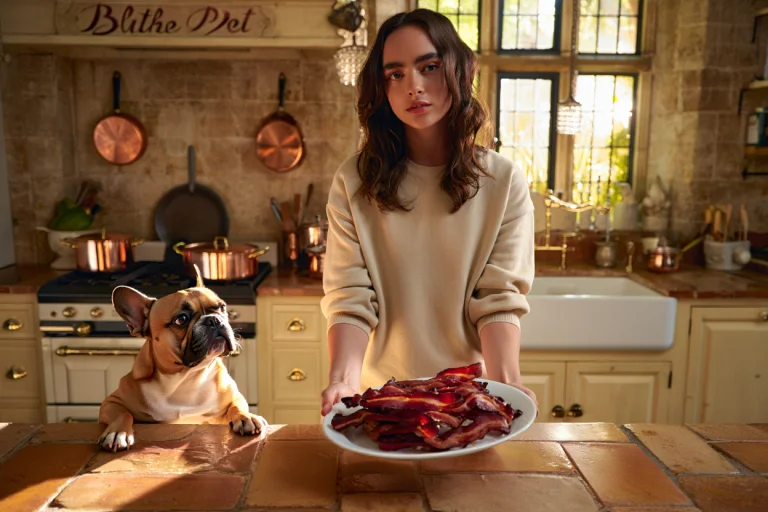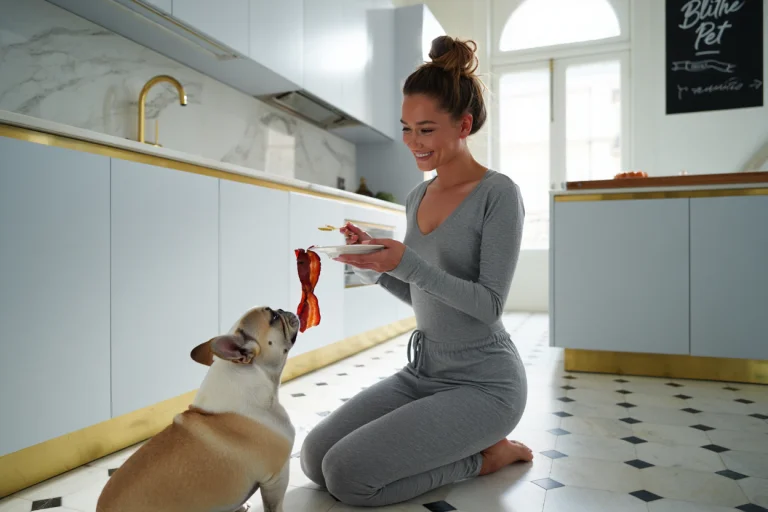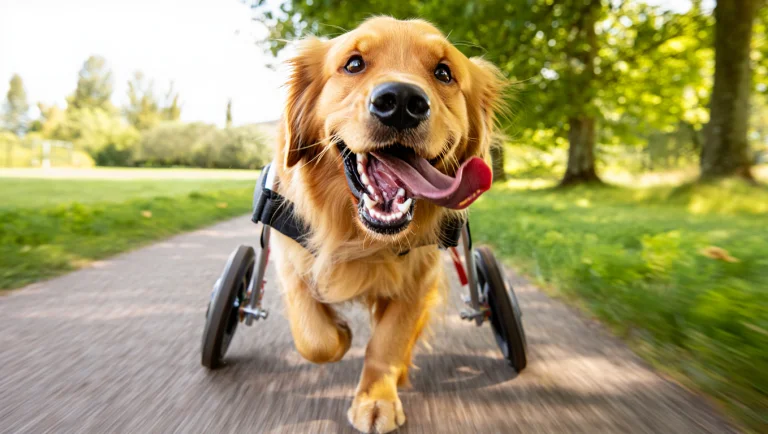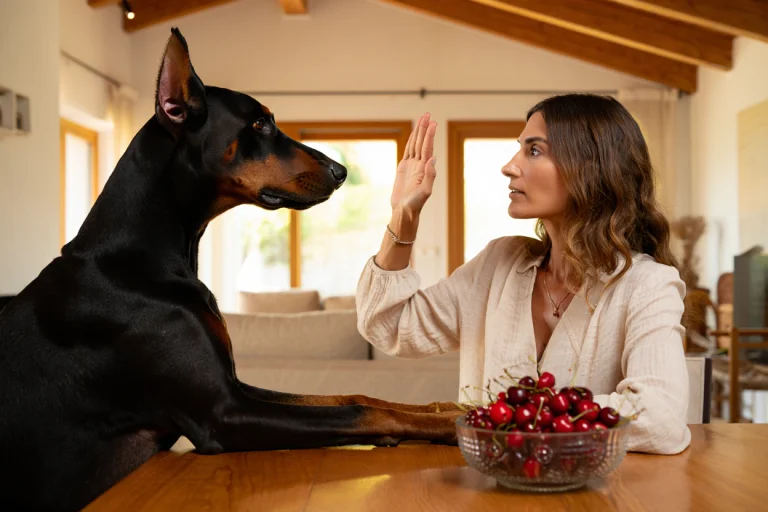Can dogs eat bacon? Discover the 6 dangerous health risks bacon poses to your furry friend and safe alternatives to protect your pup’s health.
Table of Contents

As dog owners, we’ve all experienced those pleading eyes at the breakfast table. When the irresistible aroma of sizzling bacon fills the air, your furry companion suddenly becomes your most attentive audience. The question inevitably crosses your mind: can dogs eat bacon? While sharing food with our pets can feel like an act of love, not all human foods are safe for canine consumption. Bacon, despite its mouth-watering appeal, carries several health risks for dogs that every responsible pet parent should understand. This comprehensive guide explores the relationship between dogs and bacon, revealing six crucial truths that might make you reconsider before sharing this breakfast favorite with your four-legged friend.
The Bacon Breakdown: What’s Actually in It?
Before diving into whether dogs can eat bacon, let’s understand what bacon actually is and what makes it potentially problematic for our canine companions.
What Is Bacon?
Bacon is cured pork meat, typically from the belly or back cuts of a pig. The traditional processing of bacon involves:
- Curing with salt
- Smoking (often with various wood types for flavor)
- Addition of preservatives like sodium nitrite
- Seasoning with sugar, spices, and other flavorings
A single slice of cooked bacon (approximately 8 grams) contains:
| Nutrient | Amount | % of Daily Canine Requirements |
| Calories | 43 | 2-4% for medium-sized dog |
| Fat | 3.3g | High proportion |
| Protein | 3g | Minimal nutritional benefit |
| Sodium | 137mg | Excessive |
| Nitrates | Varies | Not recommended |
The Nutritional Profile
The nutritional profile of bacon reveals why it poses concerns for dogs:
- High Fat Content: Bacon derives about 68% of its calories from fat, much of which is saturated.
- Excessive Salt: The salt content in bacon far exceeds what dogs need in their diet.
- Preservatives: Chemical additives like sodium nitrite may impact canine health differently than human health.
- Seasonings: Many bacon varieties contain garlic, onion powder, or other flavorings that are toxic to dogs.
Truth #1: Bacon’s Fat Content Is Dangerous for Dogs
The most immediate concern with feeding bacon to dogs is its extremely high fat content. While dogs do need some fat in their diet, bacon provides it in potentially harmful quantities.
The Pancreatitis Risk
Consuming fatty foods like bacon can trigger pancreatitis in dogs, a potentially life-threatening condition. Pancreatitis occurs when the pancreas becomes inflamed, disrupting digestive enzyme production and causing severe abdominal pain.
Recent statistics show:
- Pancreatitis accounts for approximately 10% of serious canine veterinary visits annually
- High-fat meals are responsible for 65% of acute pancreatitis cases in dogs
- Small and medium breeds appear particularly susceptible
Signs of Pancreatitis After Bacon Consumption
If your dog has consumed bacon and shows these symptoms, seek veterinary care immediately:
- Repeated vomiting
- Hunched back posture
- Abdominal pain or distention
- Loss of appetite
- Lethargy or depression
- Fever
- Diarrhea (sometimes with blood)
Long-Term Fat Consumption Effects
Beyond acute pancreatitis, regular consumption of fatty foods like bacon can lead to:
- Obesity (affecting over 50% of American dogs)
- Diabetes
- Joint problems and reduced mobility
- Decreased overall lifespan

Truth #2: The Sodium Trap: How Salt in Bacon Affects Dogs
Dogs require significantly less sodium in their diet than humans. A single slice of bacon can contain more sodium than a dog should consume in an entire day.
Canine Sodium Requirements vs. Bacon Content
The Association of American Feed Control Officials (AAFCO) guidelines suggest:
| Dog Size | Daily Sodium Requirement | Sodium in 2 Bacon Slices | % of Daily Requirement |
| Small (10-20 lbs) | 100mg | 275mg+ | 275% |
| Medium (30-50 lbs) | 200mg | 275mg+ | 137% |
| Large (70-90 lbs) | 400mg | 275mg+ | 68% |
Sodium Ion Poisoning Risk
Excessive sodium can lead to sodium ion poisoning, which manifests as:
- Extreme thirst
- Urination changes
- Vomiting and diarrhea
- Tremors
- Seizures
- In severe cases, death
Long-Term Salt Consumption Effects
Regular high sodium intake from foods like bacon has been linked to:
- Hypertension (high blood pressure)
- Heart disease
- Kidney damage
- Fluid retention and edema
A 2023 veterinary study found that dogs regularly exposed to high-sodium human foods showed a 30% increase in blood pressure readings over a two-year period.
Truth #3: Preservatives and Additives: The Hidden Danger
Modern bacon processing relies on chemical preservatives that may pose unique risks to canine health.
Nitrates and Nitrites
Bacon typically contains sodium nitrite and sometimes nitrates, which:
- Prevent bacterial growth
- Add flavor and color
- Can convert to nitrosamines during cooking
While the research on nitrate/nitrite effects specifically in dogs is limited, these compounds have been associated with:
- Methemoglobinemia (a blood disorder affecting oxygen transport)
- Potential carcinogenic effects over long-term exposure
- Gastrointestinal irritation
Other Problematic Additives
Commercial bacon may contain:
- Artificial flavorings: Some may cause allergic reactions or digestive upset
- Sugar: Unnecessarily adds empty calories and can contribute to obesity
- Spices: May include garlic or onion derivatives toxic to dogs
- Smoke flavoring: Can irritate sensitive canine digestive systems
Truth #4: Size Matters: Small Dogs Face Greater Bacon Risks
The size of your dog dramatically affects how bacon consumption impacts them.
The Scaling Problem
When considering whether dogs can eat bacon, size creates significant disparities in risk:
| Dog Size | Weight | Effect of One Bacon Slice |
| Toy (Chihuahua) | 5 lbs | Equivalent to human eating 5-6 slices |
| Small (Jack Russell) | 15 lbs | Equivalent to human eating 2 slices |
| Medium (Border Collie) | 40 lbs | Equivalent to human eating ¾ slice |
| Large (Labrador) | 70 lbs | Equivalent to human eating ⅓ slice |
Higher Toxicity Threshold
Smaller dogs have:
- Less body mass to distribute toxins
- Smaller organs that process substances more quickly
- Lower tolerance for fat and sodium
- Increased risk of immediate adverse reactions
Veterinary emergency data indicates that small dogs are 3.5 times more likely to require emergency treatment after consuming inappropriate human foods like bacon.

Truth #5: Cooking Methods Add New Dangers
How bacon is prepared affects its safety profile for dogs.
The Burnt Bacon Problem
Crispy, well-done bacon contains:
- Acrylamide: A compound formed when foods are cooked at high temperatures, classified as a potential carcinogen
- Heterocyclic amines (HCAs): Formed when meat is cooked at high temperatures, associated with increased cancer risk
- Polycyclic aromatic hydrocarbons (PAHs): Created when fat drips onto heat sources and produces smoke
Raw or Undercooked Risks
Conversely, undercooked bacon presents different hazards:
- Parasites: Including Trichinella spiralis
- Bacteria: Salmonella, E. coli, Listeria
- Higher fat content: Raw fat is more likely to cause immediate GI distress
A 2022 survey of emergency veterinary clinics found that 15% of food-related emergency visits involved dogs consuming raw or undercooked pork products.
Truth #6: The Psychological Impact of Sharing Bacon
Beyond physical health concerns, feeding dogs bacon can create behavioral issues that affect your relationship with your pet.
Begging Behavior Development
Dogs who receive bacon as treats often develop:
- Persistent begging behaviors
- Food fixation during meal times
- Potential food aggression or resource guarding
- Expectations for human food rather than appropriate dog food
The Reinforcement Cycle
Giving in to those pleading eyes creates a problematic pattern:
- Dog begs for food
- Owner provides bacon as reward
- Dog learns begging yields rewards
- Begging behavior intensifies and becomes more difficult to extinguish
Canine behavior specialists report that over 80% of problematic mealtime behaviors stem from inconsistent boundaries around human food sharing.
Safer Alternatives to Bacon for Dogs
If you want to treat your dog without the risks associated with bacon, consider these healthier alternatives:
Commercial Dog-Safe Bacon Alternatives
Several pet food companies now produce bacon-flavored treats specifically formulated for dogs that:
- Contain appropriate fat levels
- Have controlled sodium content
- Exclude harmful preservatives
- Provide similar sensory satisfaction
DIY Dog-Safe Bacon Alternatives
For the home chef, try these safer options:
- Turkey bacon in tiny amounts: Lower in fat but still high in sodium, so use sparingly
- Dehydrated sweet potato strips: Chewy texture with natural sweetness
- Carrot bacon: Marinated carrot strips baked until chewy
- Homemade chicken jerky: Thin slices of chicken breast, dehydrated
What to Do If Your Dog Eats Bacon
Despite our best efforts, dogs sometimes get access to foods they shouldn’t eat. If your dog manages to consume bacon, here’s what to do:
Assess the Quantity
- Small amount (crumb or tiny piece): Monitor closely for signs of distress
- Medium amount (half slice or more): Contact your veterinarian
- Large amount (multiple slices): Consider this an emergency situation
Watch for These Symptoms
Monitor your dog for:
- Vomiting or diarrhea
- Lethargy
- Excessive thirst
- Abdominal pain
- Behavioral changes
Veterinary Intervention
Your vet may recommend:
- Induced vomiting (if consumed recently)
- Activated charcoal
- IV fluids to address dehydration
- Anti-nausea medication
- Pain management
- Hospitalization for severe cases
Special Cases: When Bacon Is Even More Dangerous
Some dogs face even greater risks from bacon consumption due to pre-existing conditions:
Dogs with Pancreatitis History
Dogs who have previously experienced pancreatitis have:
- Higher recurrence risk with fatty food exposure
- More severe reactions to bacon consumption
- Often need lifelong dietary restrictions
Dogs with Kidney Disease
The high sodium content in bacon can be particularly dangerous for dogs with:
- Chronic kidney disease
- Renal insufficiency
- History of urinary stones
Senior Dogs
Older dogs have:
- Less efficient digestive systems
- More difficulty processing excess fats
- Often concurrent conditions that can be exacerbated
- Decreased ability to regulate sodium balance
FAQ About Dogs and Bacon
Can dogs eat bacon in small amounts occasionally?
While a tiny piece of bacon is unlikely to cause immediate harm in most healthy adult dogs, there’s no safe threshold to recommend. Even small amounts can trigger pancreatitis in susceptible dogs, and regular consumption of even minimal amounts can lead to long-term health problems.
What about bacon grease on dog food?
Bacon grease is even more concentrated in fat than bacon itself and should never be added to dog food. The high fat content can cause immediate digestive upset and potentially trigger pancreatitis.
Is turkey bacon safer for dogs than pork bacon?
While turkey bacon contains less fat than traditional pork bacon, it still has excessive sodium and preservatives. It’s marginally safer but still not recommended as a regular treat for dogs.
Why does my dog seem fine after eating bacon?
Dogs may not show immediate symptoms after consuming bacon, especially if they have robust digestive systems. However, the cumulative effects of high fat, sodium, and preservatives can cause problems over time. Additionally, some conditions like pancreatitis can develop 24-72 hours after consumption.
Can puppies eat bacon?
Puppies should never be given bacon. Their developing digestive systems are more sensitive than adult dogs, and establishing appropriate eating habits early is crucial for long-term health and behavior.
Are there any dog breeds that should especially avoid bacon?
Certain breeds are more predisposed to pancreatitis and should be particularly careful with fatty foods like bacon. These include:
- Miniature Schnauzers
- Yorkshire Terriers
- Cocker Spaniels
- Miniature Poodles
- Dachshunds
What about bacon-flavored dog treats?
Commercial bacon-flavored dog treats are formulated specifically for canine consumption and generally don’t contain the problematic components of actual bacon. They can be a safer way to provide the bacon flavor your dog craves.
Expert Recommendations on Dogs and Human Food
Veterinary nutritionists emphasize the importance of species-appropriate diets. Dr. Sarah Johnson, a board-certified veterinary nutritionist, notes: “A dog’s digestive system is fundamentally different from a human’s. Foods we enjoy without consequence can create serious health problems for our pets. When it comes to bacon, the risks far outweigh any momentary pleasure the dog might experience.”
The American Kennel Club recommends that treats—including dog-safe human foods—should constitute no more than 10% of a dog’s daily caloric intake. The remaining 90% should come from complete and balanced dog food appropriate for their life stage.
The Bottom Line on Dogs and Bacon
When answering the question “can dogs eat bacon,” the evidence points clearly toward avoiding this particular treat. The combination of excessive fat, dangerous sodium levels, chemical preservatives, and potential cooking-related compounds creates a risk profile that responsible pet owners should take seriously.
Instead of sharing bacon, consider:
- Building a repertoire of dog-safe treats
- Establishing consistent boundaries around human food
- Expressing love through appropriate foods, physical affection, and quality time
Take Your Pet Care Knowledge Further
Want to ensure you’re making the best dietary choices for your four-legged family member? BlithePet offers comprehensive guides on pet nutrition, health, and wellness. Our team of veterinary experts provides up-to-date information to help you navigate the complex world of pet care with confidence.
Conclusion
While those pleading eyes at the breakfast table can be hard to resist, understanding the six risky truths about dogs and bacon empowers you to make healthier choices for your canine companion. Bacon’s combination of high fat, excessive sodium, concerning preservatives, and cooking-related compounds makes it a poor choice for dogs of all sizes, with particularly severe risks for smaller breeds. By choosing appropriate alternatives and establishing consistent boundaries around human food, you’re not depriving your dog—you’re protecting them.
Have you found creative, dog-safe alternatives to bacon that your pup loves? Share your experience in the comments and help other pet parents discover new ways to safely indulge their four-legged friends!
This article is provided for informational purposes only and is not a substitute for professional veterinary advice. If you have concerns about your dog’s diet or health, consult with your veterinarian.







